International Law Assignment PDF
VerifiedAdded on 2022/01/18
|7
|2434
|155
AI Summary
Contribute Materials
Your contribution can guide someone’s learning journey. Share your
documents today.
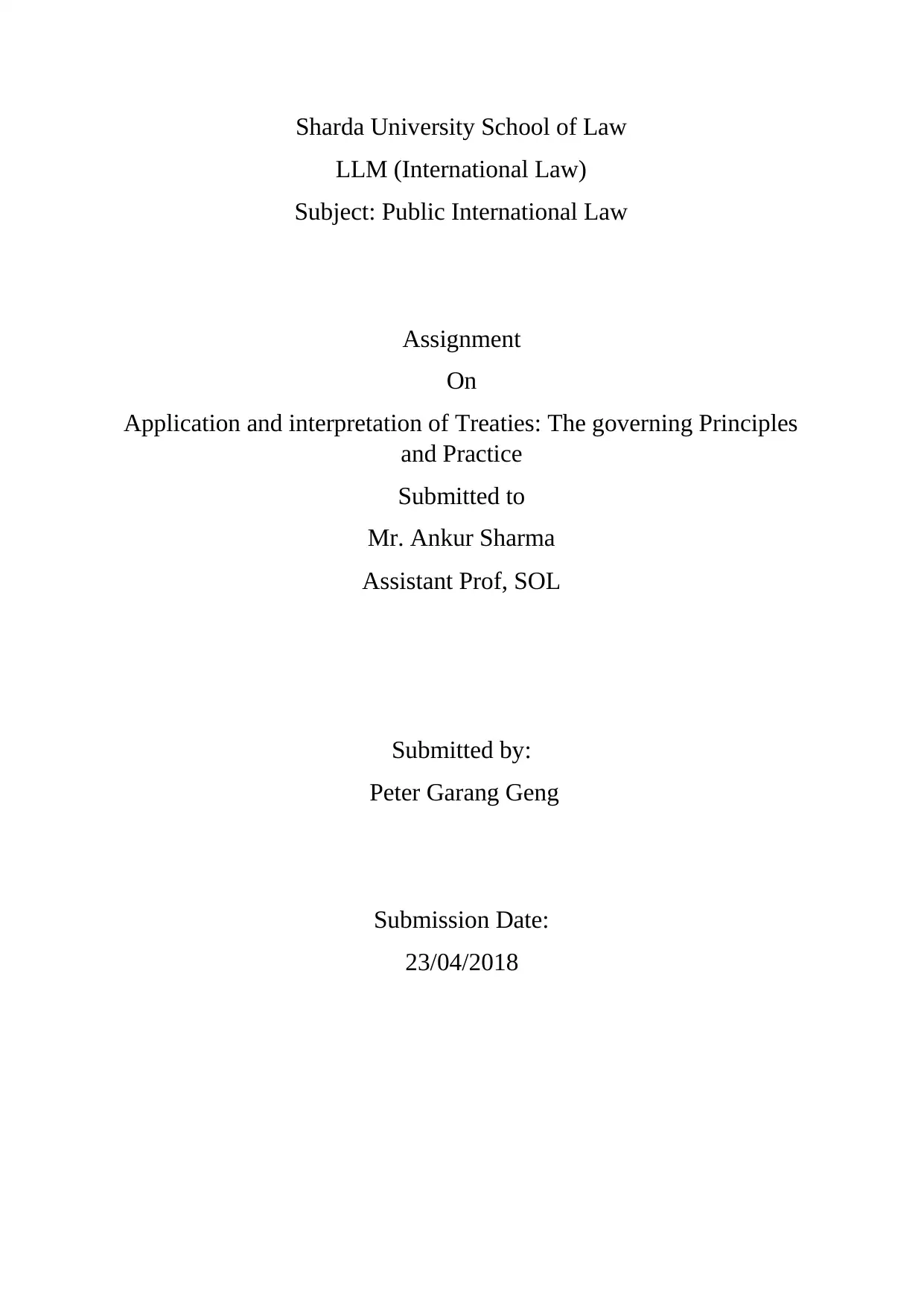
Sharda University School of Law
LLM (International Law)
Subject: Public International Law
Assignment
On
Application and interpretation of Treaties: The governing Principles
and Practice
Submitted to
Mr. Ankur Sharma
Assistant Prof, SOL
Submitted by:
Peter Garang Geng
Submission Date:
23/04/2018
LLM (International Law)
Subject: Public International Law
Assignment
On
Application and interpretation of Treaties: The governing Principles
and Practice
Submitted to
Mr. Ankur Sharma
Assistant Prof, SOL
Submitted by:
Peter Garang Geng
Submission Date:
23/04/2018
Secure Best Marks with AI Grader
Need help grading? Try our AI Grader for instant feedback on your assignments.
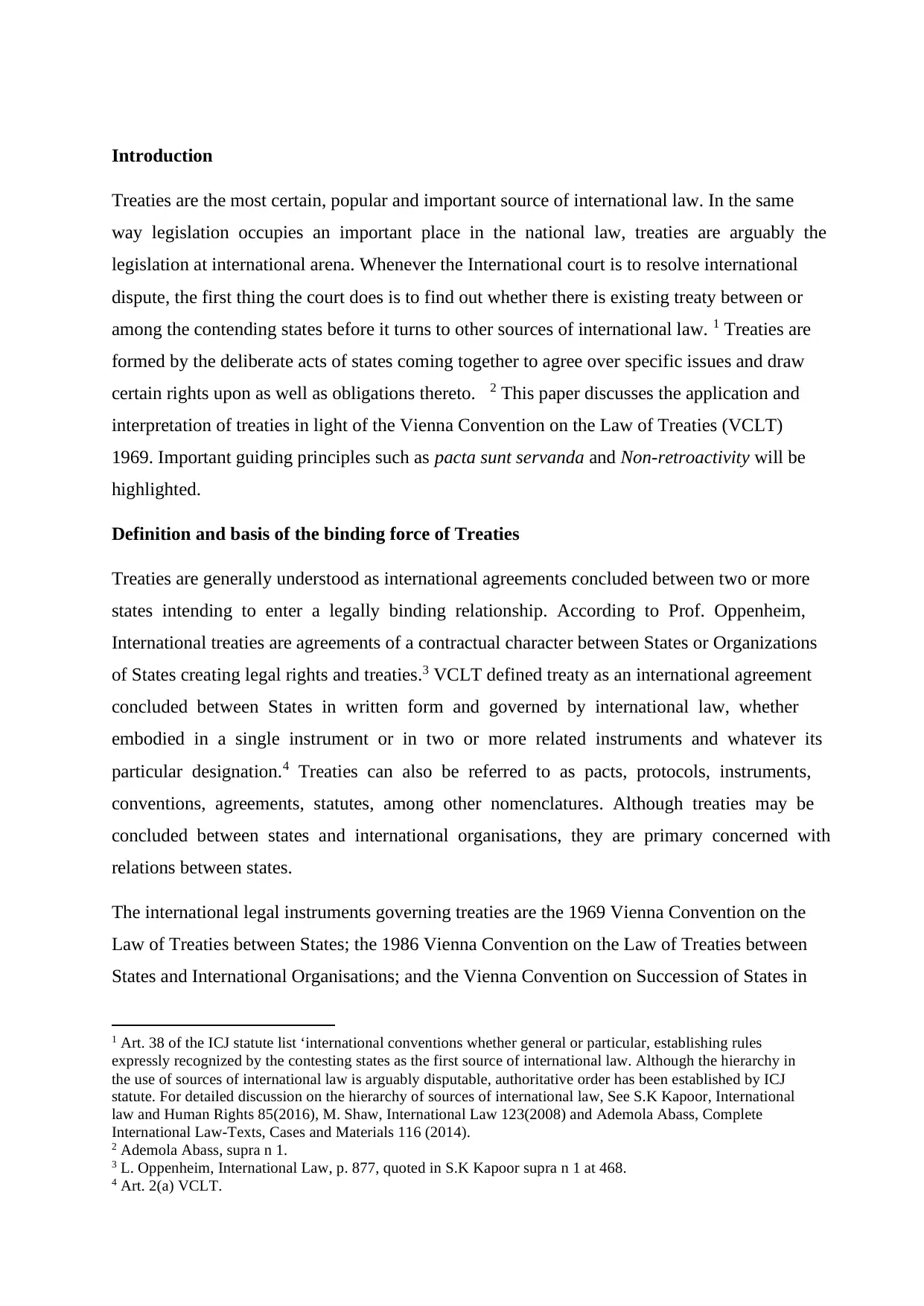
Introduction
Treaties are the most certain, popular and important source of international law. In the same
way legislation occupies an important place in the national law, treaties are arguably the
legislation at international arena. Whenever the International court is to resolve international
dispute, the first thing the court does is to find out whether there is existing treaty between or
among the contending states before it turns to other sources of international law. 1 Treaties are
formed by the deliberate acts of states coming together to agree over specific issues and draw
certain rights upon as well as obligations thereto. 2 This paper discusses the application and
interpretation of treaties in light of the Vienna Convention on the Law of Treaties (VCLT)
1969. Important guiding principles such as pacta sunt servanda and Non-retroactivity will be
highlighted.
Definition and basis of the binding force of Treaties
Treaties are generally understood as international agreements concluded between two or more
states intending to enter a legally binding relationship. According to Prof. Oppenheim,
International treaties are agreements of a contractual character between States or Organizations
of States creating legal rights and treaties.3 VCLT defined treaty as an international agreement
concluded between States in written form and governed by international law, whether
embodied in a single instrument or in two or more related instruments and whatever its
particular designation.4 Treaties can also be referred to as pacts, protocols, instruments,
conventions, agreements, statutes, among other nomenclatures. Although treaties may be
concluded between states and international organisations, they are primary concerned with
relations between states.
The international legal instruments governing treaties are the 1969 Vienna Convention on the
Law of Treaties between States; the 1986 Vienna Convention on the Law of Treaties between
States and International Organisations; and the Vienna Convention on Succession of States in
1 Art. 38 of the ICJ statute list ‘international conventions whether general or particular, establishing rules
expressly recognized by the contesting states as the first source of international law. Although the hierarchy in
the use of sources of international law is arguably disputable, authoritative order has been established by ICJ
statute. For detailed discussion on the hierarchy of sources of international law, See S.K Kapoor, International
law and Human Rights 85(2016), M. Shaw, International Law 123(2008) and Ademola Abass, Complete
International Law-Texts, Cases and Materials 116 (2014).
2 Ademola Abass, supra n 1.
3 L. Oppenheim, International Law, p. 877, quoted in S.K Kapoor supra n 1 at 468.
4 Art. 2(a) VCLT.
Treaties are the most certain, popular and important source of international law. In the same
way legislation occupies an important place in the national law, treaties are arguably the
legislation at international arena. Whenever the International court is to resolve international
dispute, the first thing the court does is to find out whether there is existing treaty between or
among the contending states before it turns to other sources of international law. 1 Treaties are
formed by the deliberate acts of states coming together to agree over specific issues and draw
certain rights upon as well as obligations thereto. 2 This paper discusses the application and
interpretation of treaties in light of the Vienna Convention on the Law of Treaties (VCLT)
1969. Important guiding principles such as pacta sunt servanda and Non-retroactivity will be
highlighted.
Definition and basis of the binding force of Treaties
Treaties are generally understood as international agreements concluded between two or more
states intending to enter a legally binding relationship. According to Prof. Oppenheim,
International treaties are agreements of a contractual character between States or Organizations
of States creating legal rights and treaties.3 VCLT defined treaty as an international agreement
concluded between States in written form and governed by international law, whether
embodied in a single instrument or in two or more related instruments and whatever its
particular designation.4 Treaties can also be referred to as pacts, protocols, instruments,
conventions, agreements, statutes, among other nomenclatures. Although treaties may be
concluded between states and international organisations, they are primary concerned with
relations between states.
The international legal instruments governing treaties are the 1969 Vienna Convention on the
Law of Treaties between States; the 1986 Vienna Convention on the Law of Treaties between
States and International Organisations; and the Vienna Convention on Succession of States in
1 Art. 38 of the ICJ statute list ‘international conventions whether general or particular, establishing rules
expressly recognized by the contesting states as the first source of international law. Although the hierarchy in
the use of sources of international law is arguably disputable, authoritative order has been established by ICJ
statute. For detailed discussion on the hierarchy of sources of international law, See S.K Kapoor, International
law and Human Rights 85(2016), M. Shaw, International Law 123(2008) and Ademola Abass, Complete
International Law-Texts, Cases and Materials 116 (2014).
2 Ademola Abass, supra n 1.
3 L. Oppenheim, International Law, p. 877, quoted in S.K Kapoor supra n 1 at 468.
4 Art. 2(a) VCLT.
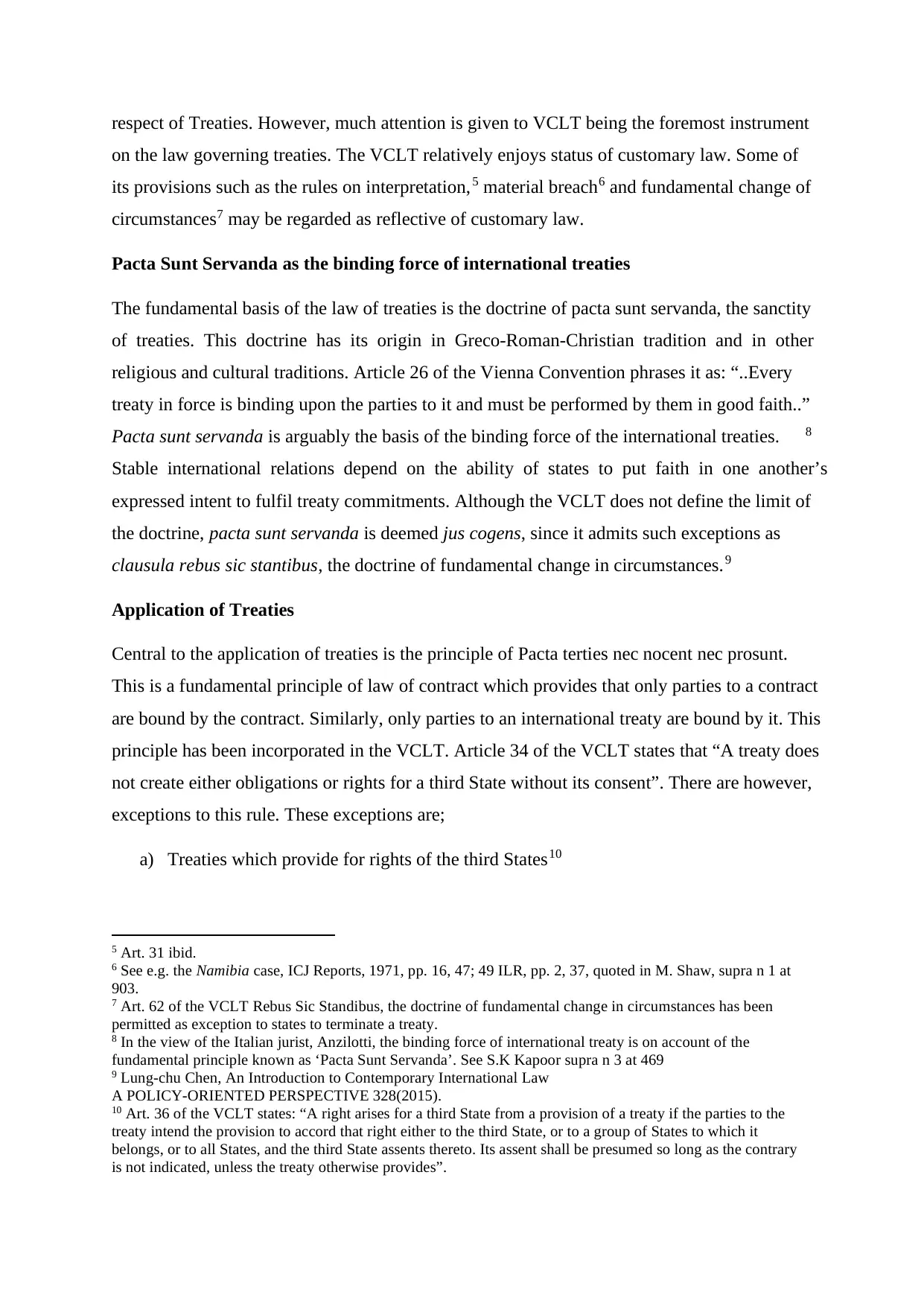
respect of Treaties. However, much attention is given to VCLT being the foremost instrument
on the law governing treaties. The VCLT relatively enjoys status of customary law. Some of
its provisions such as the rules on interpretation,5 material breach6 and fundamental change of
circumstances7 may be regarded as reflective of customary law.
Pacta Sunt Servanda as the binding force of international treaties
The fundamental basis of the law of treaties is the doctrine of pacta sunt servanda, the sanctity
of treaties. This doctrine has its origin in Greco-Roman-Christian tradition and in other
religious and cultural traditions. Article 26 of the Vienna Convention phrases it as: “..Every
treaty in force is binding upon the parties to it and must be performed by them in good faith..”
Pacta sunt servanda is arguably the basis of the binding force of the international treaties. 8
Stable international relations depend on the ability of states to put faith in one another’s
expressed intent to fulfil treaty commitments. Although the VCLT does not define the limit of
the doctrine, pacta sunt servanda is deemed jus cogens, since it admits such exceptions as
clausula rebus sic stantibus, the doctrine of fundamental change in circumstances.9
Application of Treaties
Central to the application of treaties is the principle of Pacta terties nec nocent nec prosunt.
This is a fundamental principle of law of contract which provides that only parties to a contract
are bound by the contract. Similarly, only parties to an international treaty are bound by it. This
principle has been incorporated in the VCLT. Article 34 of the VCLT states that “A treaty does
not create either obligations or rights for a third State without its consent”. There are however,
exceptions to this rule. These exceptions are;
a) Treaties which provide for rights of the third States10
5 Art. 31 ibid.
6 See e.g. the Namibia case, ICJ Reports, 1971, pp. 16, 47; 49 ILR, pp. 2, 37, quoted in M. Shaw, supra n 1 at
903.
7 Art. 62 of the VCLT Rebus Sic Standibus, the doctrine of fundamental change in circumstances has been
permitted as exception to states to terminate a treaty.
8 In the view of the Italian jurist, Anzilotti, the binding force of international treaty is on account of the
fundamental principle known as ‘Pacta Sunt Servanda’. See S.K Kapoor supra n 3 at 469
9 Lung-chu Chen, An Introduction to Contemporary International Law
A POLICY-ORIENTED PERSPECTIVE 328(2015).
10 Art. 36 of the VCLT states: “A right arises for a third State from a provision of a treaty if the parties to the
treaty intend the provision to accord that right either to the third State, or to a group of States to which it
belongs, or to all States, and the third State assents thereto. Its assent shall be presumed so long as the contrary
is not indicated, unless the treaty otherwise provides”.
on the law governing treaties. The VCLT relatively enjoys status of customary law. Some of
its provisions such as the rules on interpretation,5 material breach6 and fundamental change of
circumstances7 may be regarded as reflective of customary law.
Pacta Sunt Servanda as the binding force of international treaties
The fundamental basis of the law of treaties is the doctrine of pacta sunt servanda, the sanctity
of treaties. This doctrine has its origin in Greco-Roman-Christian tradition and in other
religious and cultural traditions. Article 26 of the Vienna Convention phrases it as: “..Every
treaty in force is binding upon the parties to it and must be performed by them in good faith..”
Pacta sunt servanda is arguably the basis of the binding force of the international treaties. 8
Stable international relations depend on the ability of states to put faith in one another’s
expressed intent to fulfil treaty commitments. Although the VCLT does not define the limit of
the doctrine, pacta sunt servanda is deemed jus cogens, since it admits such exceptions as
clausula rebus sic stantibus, the doctrine of fundamental change in circumstances.9
Application of Treaties
Central to the application of treaties is the principle of Pacta terties nec nocent nec prosunt.
This is a fundamental principle of law of contract which provides that only parties to a contract
are bound by the contract. Similarly, only parties to an international treaty are bound by it. This
principle has been incorporated in the VCLT. Article 34 of the VCLT states that “A treaty does
not create either obligations or rights for a third State without its consent”. There are however,
exceptions to this rule. These exceptions are;
a) Treaties which provide for rights of the third States10
5 Art. 31 ibid.
6 See e.g. the Namibia case, ICJ Reports, 1971, pp. 16, 47; 49 ILR, pp. 2, 37, quoted in M. Shaw, supra n 1 at
903.
7 Art. 62 of the VCLT Rebus Sic Standibus, the doctrine of fundamental change in circumstances has been
permitted as exception to states to terminate a treaty.
8 In the view of the Italian jurist, Anzilotti, the binding force of international treaty is on account of the
fundamental principle known as ‘Pacta Sunt Servanda’. See S.K Kapoor supra n 3 at 469
9 Lung-chu Chen, An Introduction to Contemporary International Law
A POLICY-ORIENTED PERSPECTIVE 328(2015).
10 Art. 36 of the VCLT states: “A right arises for a third State from a provision of a treaty if the parties to the
treaty intend the provision to accord that right either to the third State, or to a group of States to which it
belongs, or to all States, and the third State assents thereto. Its assent shall be presumed so long as the contrary
is not indicated, unless the treaty otherwise provides”.
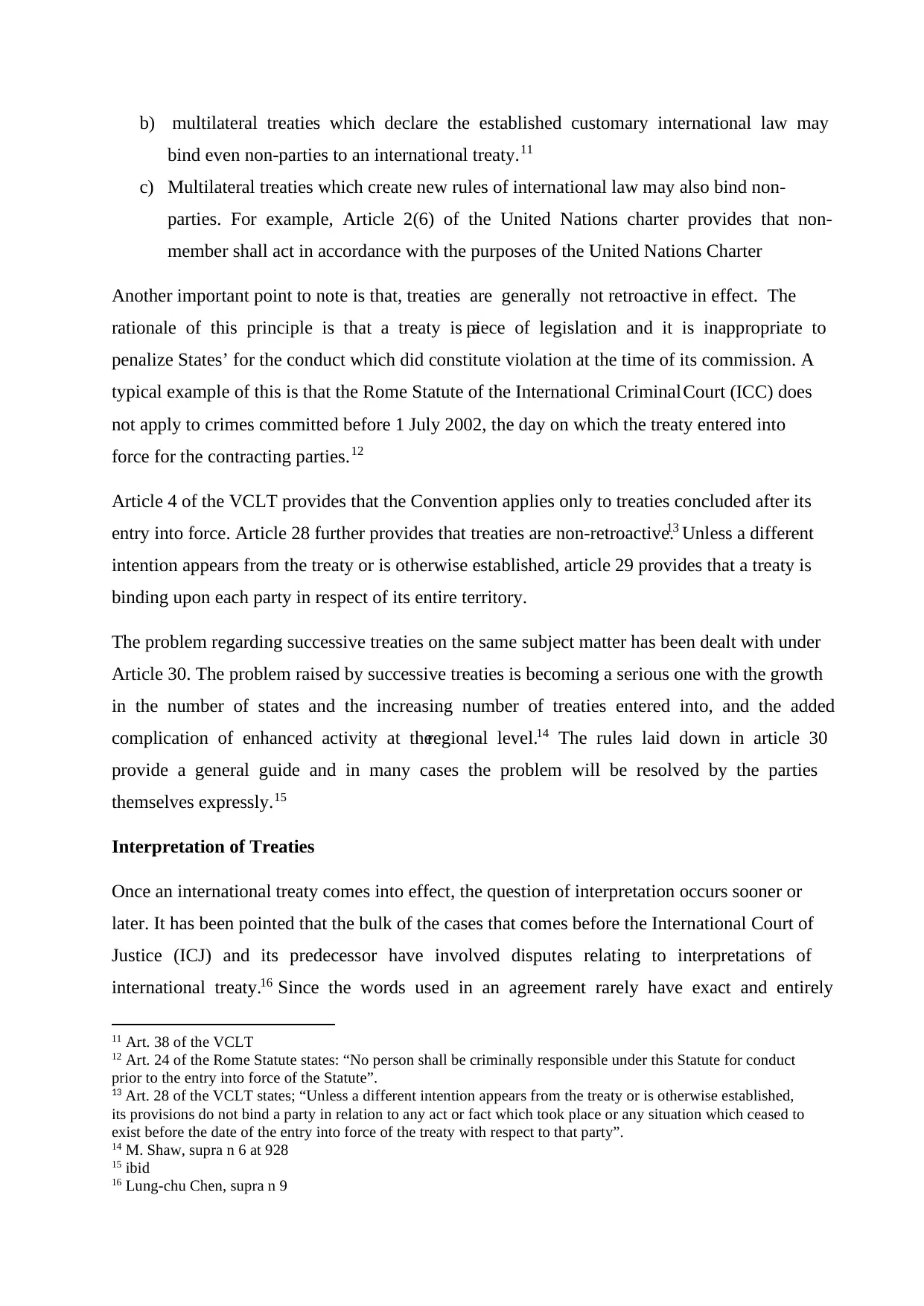
b) multilateral treaties which declare the established customary international law may
bind even non-parties to an international treaty.11
c) Multilateral treaties which create new rules of international law may also bind non-
parties. For example, Article 2(6) of the United Nations charter provides that non-
member shall act in accordance with the purposes of the United Nations Charter
Another important point to note is that, treaties are generally not retroactive in effect. The
rationale of this principle is that a treaty is apiece of legislation and it is inappropriate to
penalize States’ for the conduct which did constitute violation at the time of its commission. A
typical example of this is that the Rome Statute of the International Criminal Court (ICC) does
not apply to crimes committed before 1 July 2002, the day on which the treaty entered into
force for the contracting parties.12
Article 4 of the VCLT provides that the Convention applies only to treaties concluded after its
entry into force. Article 28 further provides that treaties are non-retroactive.13 Unless a different
intention appears from the treaty or is otherwise established, article 29 provides that a treaty is
binding upon each party in respect of its entire territory.
The problem regarding successive treaties on the same subject matter has been dealt with under
Article 30. The problem raised by successive treaties is becoming a serious one with the growth
in the number of states and the increasing number of treaties entered into, and the added
complication of enhanced activity at theregional level.14 The rules laid down in article 30
provide a general guide and in many cases the problem will be resolved by the parties
themselves expressly.15
Interpretation of Treaties
Once an international treaty comes into effect, the question of interpretation occurs sooner or
later. It has been pointed that the bulk of the cases that comes before the International Court of
Justice (ICJ) and its predecessor have involved disputes relating to interpretations of
international treaty.16 Since the words used in an agreement rarely have exact and entirely
11 Art. 38 of the VCLT
12 Art. 24 of the Rome Statute states: “No person shall be criminally responsible under this Statute for conduct
prior to the entry into force of the Statute”.
13 Art. 28 of the VCLT states; “Unless a different intention appears from the treaty or is otherwise established,
its provisions do not bind a party in relation to any act or fact which took place or any situation which ceased to
exist before the date of the entry into force of the treaty with respect to that party”.
14 M. Shaw, supra n 6 at 928
15 ibid
16 Lung-chu Chen, supra n 9
bind even non-parties to an international treaty.11
c) Multilateral treaties which create new rules of international law may also bind non-
parties. For example, Article 2(6) of the United Nations charter provides that non-
member shall act in accordance with the purposes of the United Nations Charter
Another important point to note is that, treaties are generally not retroactive in effect. The
rationale of this principle is that a treaty is apiece of legislation and it is inappropriate to
penalize States’ for the conduct which did constitute violation at the time of its commission. A
typical example of this is that the Rome Statute of the International Criminal Court (ICC) does
not apply to crimes committed before 1 July 2002, the day on which the treaty entered into
force for the contracting parties.12
Article 4 of the VCLT provides that the Convention applies only to treaties concluded after its
entry into force. Article 28 further provides that treaties are non-retroactive.13 Unless a different
intention appears from the treaty or is otherwise established, article 29 provides that a treaty is
binding upon each party in respect of its entire territory.
The problem regarding successive treaties on the same subject matter has been dealt with under
Article 30. The problem raised by successive treaties is becoming a serious one with the growth
in the number of states and the increasing number of treaties entered into, and the added
complication of enhanced activity at theregional level.14 The rules laid down in article 30
provide a general guide and in many cases the problem will be resolved by the parties
themselves expressly.15
Interpretation of Treaties
Once an international treaty comes into effect, the question of interpretation occurs sooner or
later. It has been pointed that the bulk of the cases that comes before the International Court of
Justice (ICJ) and its predecessor have involved disputes relating to interpretations of
international treaty.16 Since the words used in an agreement rarely have exact and entirely
11 Art. 38 of the VCLT
12 Art. 24 of the Rome Statute states: “No person shall be criminally responsible under this Statute for conduct
prior to the entry into force of the Statute”.
13 Art. 28 of the VCLT states; “Unless a different intention appears from the treaty or is otherwise established,
its provisions do not bind a party in relation to any act or fact which took place or any situation which ceased to
exist before the date of the entry into force of the treaty with respect to that party”.
14 M. Shaw, supra n 6 at 928
15 ibid
16 Lung-chu Chen, supra n 9
Secure Best Marks with AI Grader
Need help grading? Try our AI Grader for instant feedback on your assignments.
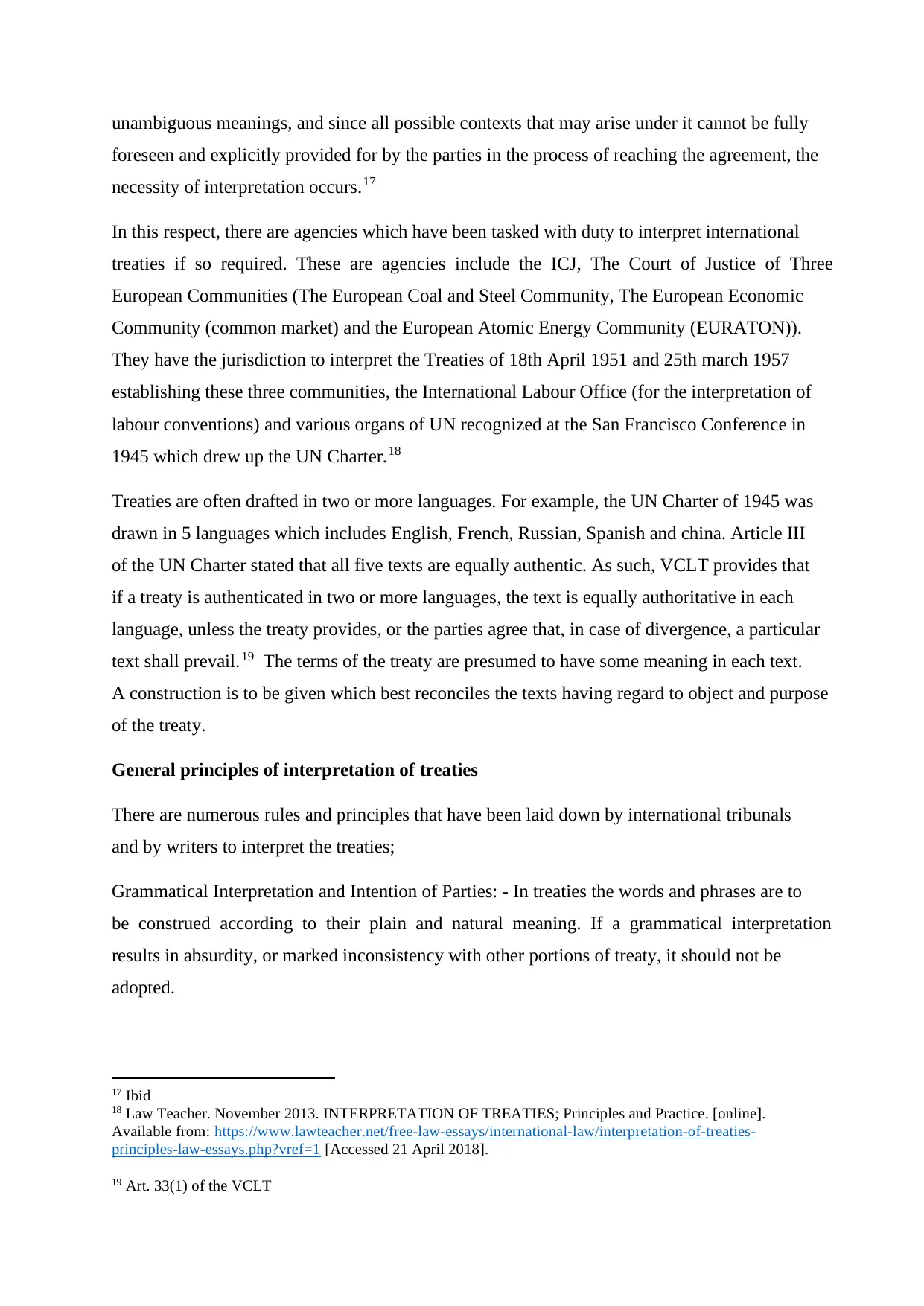
unambiguous meanings, and since all possible contexts that may arise under it cannot be fully
foreseen and explicitly provided for by the parties in the process of reaching the agreement, the
necessity of interpretation occurs.17
In this respect, there are agencies which have been tasked with duty to interpret international
treaties if so required. These are agencies include the ICJ, The Court of Justice of Three
European Communities (The European Coal and Steel Community, The European Economic
Community (common market) and the European Atomic Energy Community (EURATON)).
They have the jurisdiction to interpret the Treaties of 18th April 1951 and 25th march 1957
establishing these three communities, the International Labour Office (for the interpretation of
labour conventions) and various organs of UN recognized at the San Francisco Conference in
1945 which drew up the UN Charter.18
Treaties are often drafted in two or more languages. For example, the UN Charter of 1945 was
drawn in 5 languages which includes English, French, Russian, Spanish and china. Article III
of the UN Charter stated that all five texts are equally authentic. As such, VCLT provides that
if a treaty is authenticated in two or more languages, the text is equally authoritative in each
language, unless the treaty provides, or the parties agree that, in case of divergence, a particular
text shall prevail.19 The terms of the treaty are presumed to have some meaning in each text.
A construction is to be given which best reconciles the texts having regard to object and purpose
of the treaty.
General principles of interpretation of treaties
There are numerous rules and principles that have been laid down by international tribunals
and by writers to interpret the treaties;
Grammatical Interpretation and Intention of Parties: - In treaties the words and phrases are to
be construed according to their plain and natural meaning. If a grammatical interpretation
results in absurdity, or marked inconsistency with other portions of treaty, it should not be
adopted.
17 Ibid
18 Law Teacher. November 2013. INTERPRETATION OF TREATIES; Principles and Practice. [online].
Available from: https://www.lawteacher.net/free-law-essays/international-law/interpretation-of-treaties-
principles-law-essays.php?vref=1 [Accessed 21 April 2018].
19 Art. 33(1) of the VCLT
foreseen and explicitly provided for by the parties in the process of reaching the agreement, the
necessity of interpretation occurs.17
In this respect, there are agencies which have been tasked with duty to interpret international
treaties if so required. These are agencies include the ICJ, The Court of Justice of Three
European Communities (The European Coal and Steel Community, The European Economic
Community (common market) and the European Atomic Energy Community (EURATON)).
They have the jurisdiction to interpret the Treaties of 18th April 1951 and 25th march 1957
establishing these three communities, the International Labour Office (for the interpretation of
labour conventions) and various organs of UN recognized at the San Francisco Conference in
1945 which drew up the UN Charter.18
Treaties are often drafted in two or more languages. For example, the UN Charter of 1945 was
drawn in 5 languages which includes English, French, Russian, Spanish and china. Article III
of the UN Charter stated that all five texts are equally authentic. As such, VCLT provides that
if a treaty is authenticated in two or more languages, the text is equally authoritative in each
language, unless the treaty provides, or the parties agree that, in case of divergence, a particular
text shall prevail.19 The terms of the treaty are presumed to have some meaning in each text.
A construction is to be given which best reconciles the texts having regard to object and purpose
of the treaty.
General principles of interpretation of treaties
There are numerous rules and principles that have been laid down by international tribunals
and by writers to interpret the treaties;
Grammatical Interpretation and Intention of Parties: - In treaties the words and phrases are to
be construed according to their plain and natural meaning. If a grammatical interpretation
results in absurdity, or marked inconsistency with other portions of treaty, it should not be
adopted.
17 Ibid
18 Law Teacher. November 2013. INTERPRETATION OF TREATIES; Principles and Practice. [online].
Available from: https://www.lawteacher.net/free-law-essays/international-law/interpretation-of-treaties-
principles-law-essays.php?vref=1 [Accessed 21 April 2018].
19 Art. 33(1) of the VCLT
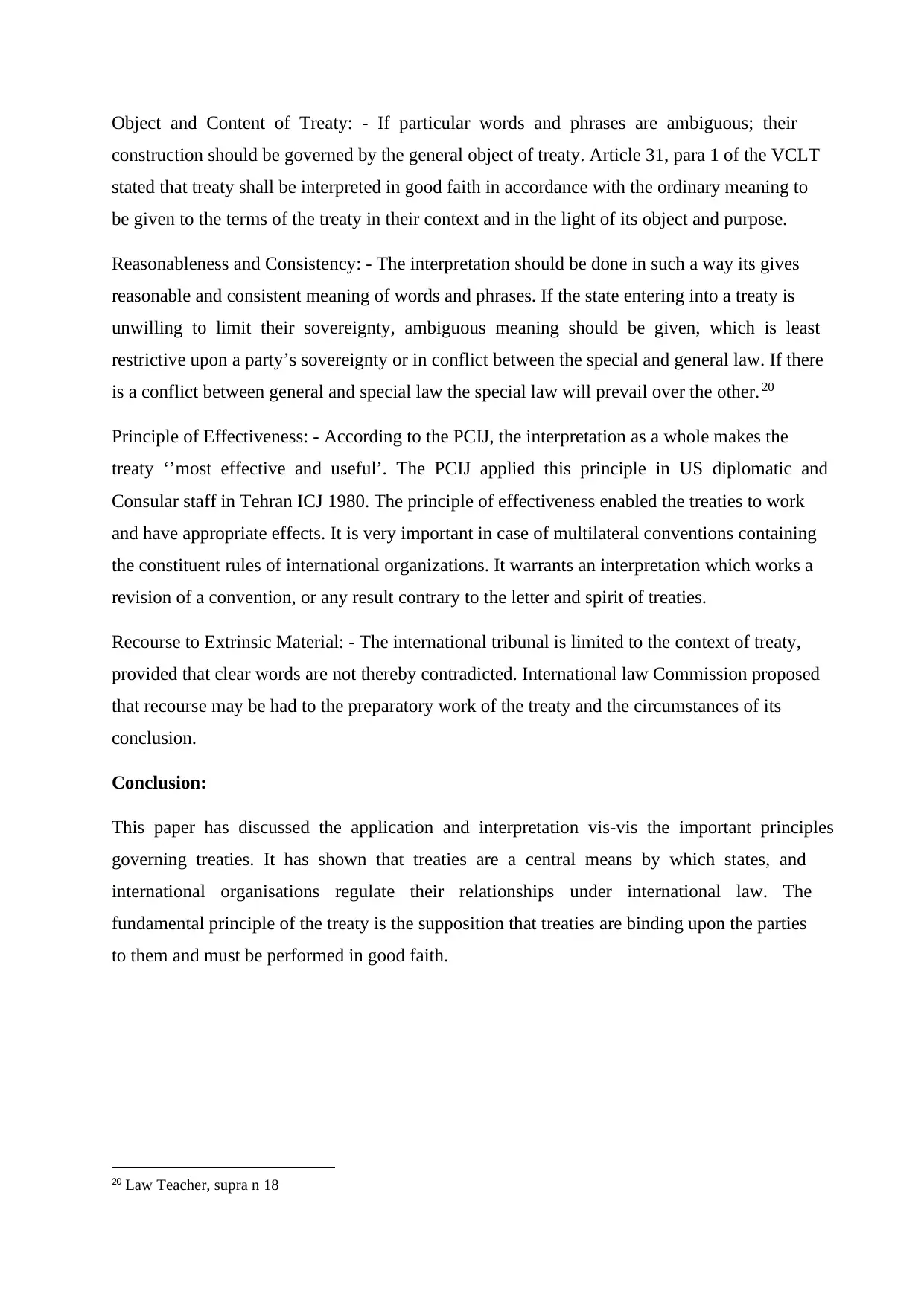
Object and Content of Treaty: - If particular words and phrases are ambiguous; their
construction should be governed by the general object of treaty. Article 31, para 1 of the VCLT
stated that treaty shall be interpreted in good faith in accordance with the ordinary meaning to
be given to the terms of the treaty in their context and in the light of its object and purpose.
Reasonableness and Consistency: - The interpretation should be done in such a way its gives
reasonable and consistent meaning of words and phrases. If the state entering into a treaty is
unwilling to limit their sovereignty, ambiguous meaning should be given, which is least
restrictive upon a party’s sovereignty or in conflict between the special and general law. If there
is a conflict between general and special law the special law will prevail over the other. 20
Principle of Effectiveness: - According to the PCIJ, the interpretation as a whole makes the
treaty ‘’most effective and useful’. The PCIJ applied this principle in US diplomatic and
Consular staff in Tehran ICJ 1980. The principle of effectiveness enabled the treaties to work
and have appropriate effects. It is very important in case of multilateral conventions containing
the constituent rules of international organizations. It warrants an interpretation which works a
revision of a convention, or any result contrary to the letter and spirit of treaties.
Recourse to Extrinsic Material: - The international tribunal is limited to the context of treaty,
provided that clear words are not thereby contradicted. International law Commission proposed
that recourse may be had to the preparatory work of the treaty and the circumstances of its
conclusion.
Conclusion:
This paper has discussed the application and interpretation vis-vis the important principles
governing treaties. It has shown that treaties are a central means by which states, and
international organisations regulate their relationships under international law. The
fundamental principle of the treaty is the supposition that treaties are binding upon the parties
to them and must be performed in good faith.
20 Law Teacher, supra n 18
construction should be governed by the general object of treaty. Article 31, para 1 of the VCLT
stated that treaty shall be interpreted in good faith in accordance with the ordinary meaning to
be given to the terms of the treaty in their context and in the light of its object and purpose.
Reasonableness and Consistency: - The interpretation should be done in such a way its gives
reasonable and consistent meaning of words and phrases. If the state entering into a treaty is
unwilling to limit their sovereignty, ambiguous meaning should be given, which is least
restrictive upon a party’s sovereignty or in conflict between the special and general law. If there
is a conflict between general and special law the special law will prevail over the other. 20
Principle of Effectiveness: - According to the PCIJ, the interpretation as a whole makes the
treaty ‘’most effective and useful’. The PCIJ applied this principle in US diplomatic and
Consular staff in Tehran ICJ 1980. The principle of effectiveness enabled the treaties to work
and have appropriate effects. It is very important in case of multilateral conventions containing
the constituent rules of international organizations. It warrants an interpretation which works a
revision of a convention, or any result contrary to the letter and spirit of treaties.
Recourse to Extrinsic Material: - The international tribunal is limited to the context of treaty,
provided that clear words are not thereby contradicted. International law Commission proposed
that recourse may be had to the preparatory work of the treaty and the circumstances of its
conclusion.
Conclusion:
This paper has discussed the application and interpretation vis-vis the important principles
governing treaties. It has shown that treaties are a central means by which states, and
international organisations regulate their relationships under international law. The
fundamental principle of the treaty is the supposition that treaties are binding upon the parties
to them and must be performed in good faith.
20 Law Teacher, supra n 18
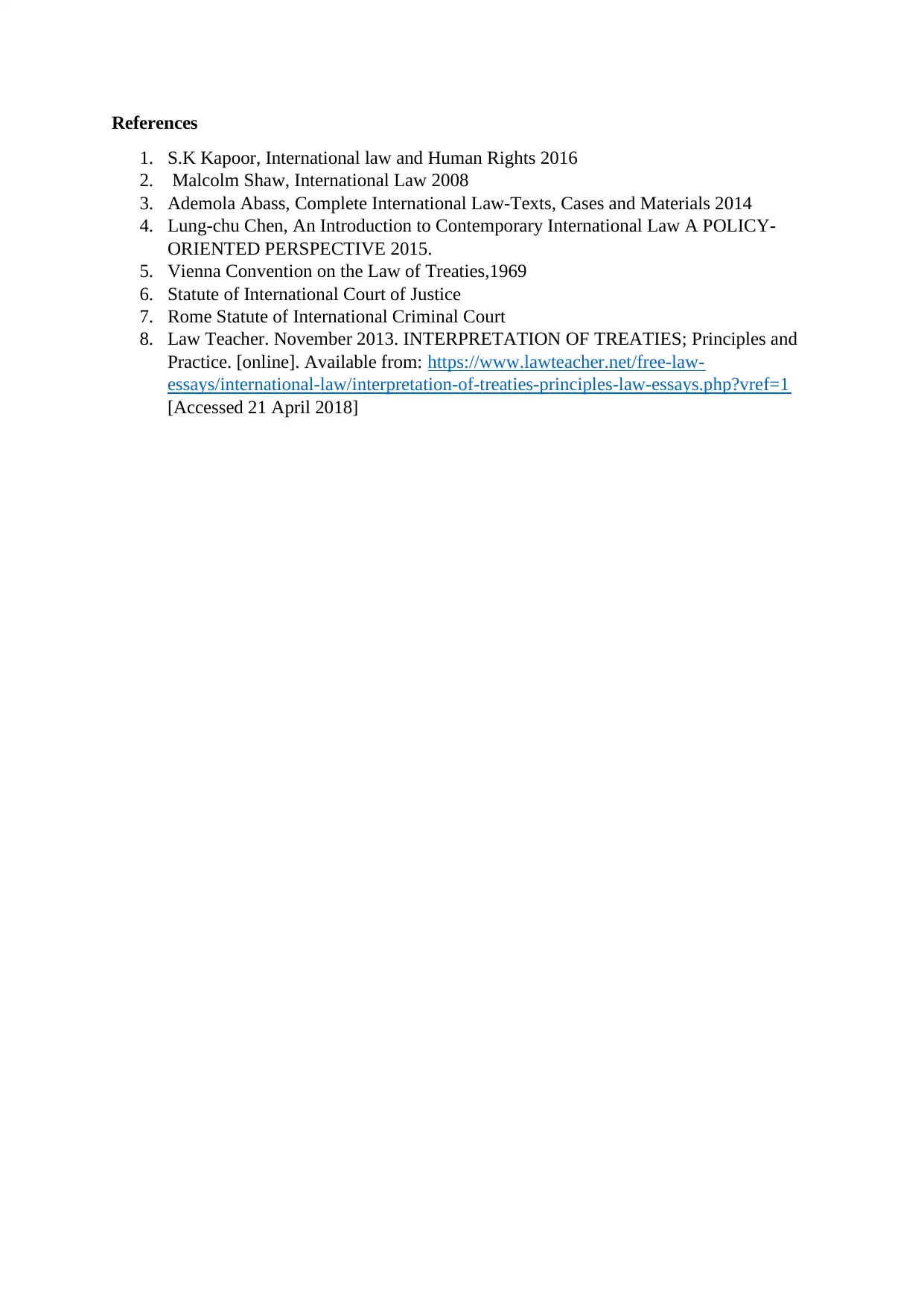
References
1. S.K Kapoor, International law and Human Rights 2016
2. Malcolm Shaw, International Law 2008
3. Ademola Abass, Complete International Law-Texts, Cases and Materials 2014
4. Lung-chu Chen, An Introduction to Contemporary International Law A POLICY-
ORIENTED PERSPECTIVE 2015.
5. Vienna Convention on the Law of Treaties,1969
6. Statute of International Court of Justice
7. Rome Statute of International Criminal Court
8. Law Teacher. November 2013. INTERPRETATION OF TREATIES; Principles and
Practice. [online]. Available from: https://www.lawteacher.net/free-law-
essays/international-law/interpretation-of-treaties-principles-law-essays.php?vref=1
[Accessed 21 April 2018]
1. S.K Kapoor, International law and Human Rights 2016
2. Malcolm Shaw, International Law 2008
3. Ademola Abass, Complete International Law-Texts, Cases and Materials 2014
4. Lung-chu Chen, An Introduction to Contemporary International Law A POLICY-
ORIENTED PERSPECTIVE 2015.
5. Vienna Convention on the Law of Treaties,1969
6. Statute of International Court of Justice
7. Rome Statute of International Criminal Court
8. Law Teacher. November 2013. INTERPRETATION OF TREATIES; Principles and
Practice. [online]. Available from: https://www.lawteacher.net/free-law-
essays/international-law/interpretation-of-treaties-principles-law-essays.php?vref=1
[Accessed 21 April 2018]
1 out of 7
Related Documents
Your All-in-One AI-Powered Toolkit for Academic Success.
+13062052269
info@desklib.com
Available 24*7 on WhatsApp / Email
![[object Object]](/_next/static/media/star-bottom.7253800d.svg)
Unlock your academic potential
© 2024 | Zucol Services PVT LTD | All rights reserved.



